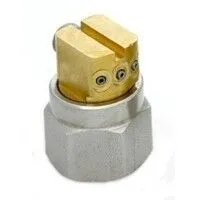Hot melt adhesive systems are essential in various industries, from packaging to automotive assembly. However, when hot melt nozzles experience issues, it can lead to production delays, defective bonding, and increased maintenance costs. Understanding the common problems with hot melt nozzles and knowing how to fix them can help maintain efficiency and ensure consistent adhesive application.
- Clogging and BlockagesProblem:
Over time, adhesive residue, dust, and debris can accumulate inside the nozzle, leading to blockages that disrupt adhesive flow. This results in inconsistent application, weak bonds, and downtime for cleaning or repairs.
Solution:
- Regular Cleaning: Implement a routine cleaning schedule using appropriate cleaning agents.
- Use High-Quality Adhesives: Lower-quality adhesives may contain impurities that contribute to clogging.
- Prevent Overheating: Excessive heat can cause adhesive charring, which can lead to buildup and clogs.
- Flush the System: Periodically use a nozzle flushing agent to clear internal residue.
- Dripping or StringingProblem:
If the nozzle continues to dispense adhesive after the trigger is released, it can cause stringing or excess adhesive on products.
Solution:
- Check the Nozzle Tip: A worn-out or damaged nozzle tip may need to be replaced.
- Adjust Temperature Settings: Excessively high temperatures can cause low-viscosity adhesive to drip.
- Ensure Proper Pressure Settings: Incorrect pressure can lead to inconsistent adhesive dispensing.
- Uneven Adhesive ApplicationProblem:
If the adhesive is applied unevenly, it can weaken bonds and lead to product defects. This issue may be caused by worn-out nozzles, incorrect settings, or contamination.
Solution:
- Inspect and Replace Nozzles: Worn or damaged nozzles should be replaced immediately.
- Ensure Consistent Temperature and Pressure: Fluctuations in temperature or pressure can result in uneven application.
- Use the Right Nozzle for the Job: Ensure that you are using the correct nozzle type for your specific adhesive and application.
- Adhesive Charring and Burnt ResidueProblem:
Adhesive charring occurs when adhesive is overheated, causing burnt residue that can clog the nozzle and lead to inconsistent application.
Solution:
- Monitor Temperature Settings: Keep temperatures within the manufacturer’s recommended range.
- Use High-Quality Adhesives: Low-quality adhesives may degrade more quickly at high temperatures.
- Clean Nozzles Regularly: Prevent residue buildup by performing routine maintenance.
- Nozzle Wear and DamageProblem:
Continuous use can cause nozzle tips to wear down or become damaged, affecting adhesive flow and precision.
Solution:
- Replace Nozzles When Necessary: Worn-out nozzles should be swapped out to maintain performance.
- Use Durable, High-Quality Nozzles: Investing in nozzles made from robust materials can extend their lifespan.
- Ensure Proper Handling: Avoid using sharp tools to clean nozzles, as this can cause damage.
- Misalignment and Poor Adhesive PlacementProblem:
If the adhesive is not being applied in the correct location, it can result in weak bonds and product inconsistencies.
Solution:
- Check for Loose Components: Ensure that the nozzle is securely attached and aligned properly.
- Calibrate the System: Periodic calibration can help maintain accurate adhesive placement.
- Use the Right Nozzle Shape: Different nozzle designs offer varied application precision—choose one that suits your needs.
Preventative Maintenance Tips
To avoid common hot melt nozzle issues, implement these best practices:
- Schedule Regular Inspections: Early detection of wear or buildup can prevent major failures.
- Use High-Quality Adhesives and Nozzles: Investing in reliable materials reduces long-term maintenance issues.
- Train Operators on Proper Usage: Ensure staff is knowledgeable about optimal settings and maintenance procedures.
- Take Advantage of Free Inspections: Companies like Adhesive Laundry offer free nozzle inspection audits to help identify potential issues before they escalate.
Conclusion
Hot melt nozzles are a critical component of adhesive application systems, and common problems like clogging, dripping, uneven application, and nozzle wear can cause costly downtime. By implementing regular maintenance, using high-quality components, and ensuring proper system settings, you can keep your adhesive operations running smoothly. If you need expert assistance, Adhesive Laundry provides professional support and free nozzle inspections to help maintain optimal performance.


